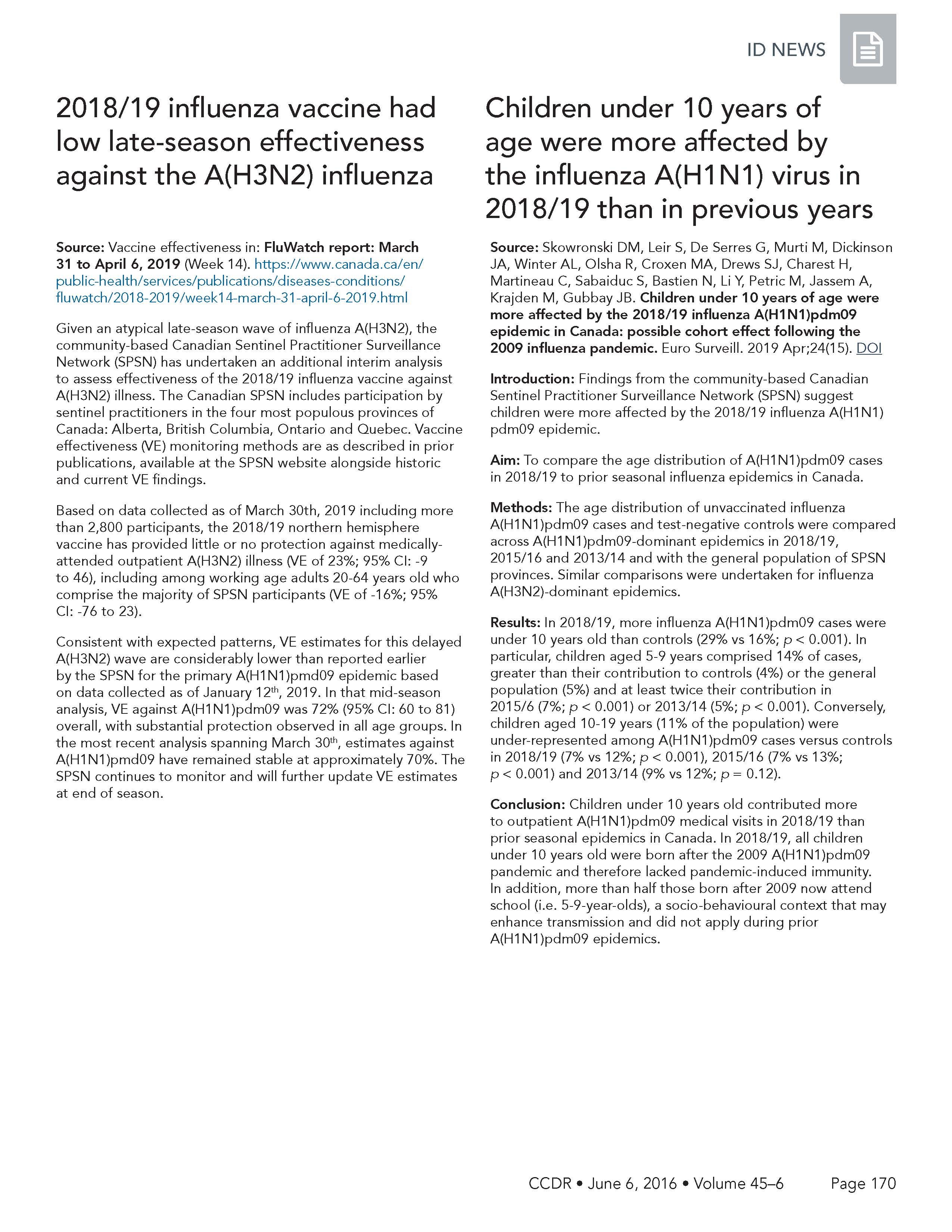Archived - 2018–2019 influenza vaccine low effectiveness against A(H3N2)

 Download this article as a PDF
Download this article as a PDFPublished by: The Public Health Agency of Canada
Issue: Volume 45-6: Influenza: An update
Date published: June 6, 2019
ISSN: 1481-8531
Submit a manuscript
About CCDR
Browse
Volume 45-6, June 6, 2019: Influenza: An update
ID News
2018/19 influenza vaccine had low late-season effectiveness against the A(H3N2) influenza virus
Source: Vaccine effectiveness in: FluWatch report: March 31 to April 6, 2019 (Week 14).
Given an atypical late-season wave of influenza A(H3N2), the community-based Canadian Sentinel Practitioner Surveillance Network (SPSN) has undertaken an additional interim analysis to assess effectiveness of the 2018/19 influenza vaccine against A(H3N2) illness. The Canadian SPSN includes participation by sentinel practitioners in the four most populous provinces of Canada: Alberta, British Columbia, Ontario and Quebec. Vaccine effectiveness (VE) monitoring methods are as described in prior publications, available at the SPSN website alongside historic and current VE findings.
Based on data collected as of March 30th, 2019 including more than 2,800 participants, the 2018/19 northern hemisphere vaccine has provided little or no protection against medically-attended outpatient A(H3N2) illness (VE of 23%; 95% CI: -9 to 46), including among working age adults 20-64 years old who comprise the majority of SPSN participants (VE of -16%; 95% CI: -76 to 23).
Consistent with expected patterns, VE estimates for this delayed A(H3N2) wave are considerably lower than reported earlier by the SPSN for the primary A(H1N1)pmd09 epidemic based on data collected as of January 12th, 2019. In that mid-season analysis, VE against A(H1N1)pdm09 was 72% (95% CI: 60 to 81) overall, with substantial protection observed in all age groups. In the most recent analysis spanning March 30th, estimates against A(H1N1)pmd09 have remained stable at approximately 70%. The SPSN continues to monitor and will further update VE estimates at end of season.
Children under 10 years of age were more affected by the influenza A(H1N1) virus in 2018/19 than in previous years
Source: Skowronski DM, Leir S, De Serres G, Murti M, Dickinson JA, Winter AL, Olsha R, Croxen MA, Drews SJ, Charest H, Martineau C, Sabaiduc S, Bastien N, Li Y, Petric M, Jassem A, Krajden M, Gubbay JB. Children under 10 years of age were more affected by the 2018/19 influenza A(H1N1)pdm09 epidemic in Canada: possible cohort effect following the 2009 influenza pandemic. Euro Surveill 2019 Apr;24(15).
Introduction: Findings from the community-based Canadian Sentinel Practitioner Surveillance Network (SPSN) suggest children were more affected by the 2018/19 influenza A(H1N1)pdm09 epidemic.
Aim: To compare the age distribution of A(H1N1)pdm09 cases in 2018/19 to prior seasonal influenza epidemics in Canada.
Methods: The age distribution of unvaccinated influenza A(H1N1)pdm09 cases and test-negative controls were compared across A(H1N1)pdm09-dominant epidemics in 2018/19, 2015/16 and 2013/14 and with the general population of SPSN provinces. Similar comparisons were undertaken for influenza A(H3N2)-dominant epidemics.
Results: In 2018/19, more influenza A(H1N1)pdm09 cases were under 10 years old than controls (29% vs 16%; p < 0.001). In particular, children aged 5-9 years comprised 14% of cases, greater than their contribution to controls (4%) or the general population (5%) and at least twice their contribution in 2015/16 (7%; p < 0.001) or 2013/14 (5%; p < 0.001). Conversely, children aged 10-19 years (11% of the population) were under-represented among A(H1N1)pdm09 cases versus controls in 2018/19 (7% vs 12%; p < 0.001), 2015/16 (7% vs 13%; p < 0.001) and 2013/14 (9% vs 12%; p = 0.12).
Conclusion: Children under 10 years old contributed more to outpatient A(H1N1)pdm09 medical visits in 2018/19 than prior seasonal epidemics in Canada. In 2018/19, all children under 10 years old were born after the 2009 A(H1N1)pdm09 pandemic and therefore lacked pandemic-induced immunity. In addition, more than half those born after 2009 now attend school (i.e. 5-9-year-olds), a socio-behavioural context that may enhance transmission and did not apply during prior A(H1N1)pdm09 epidemics.
